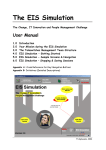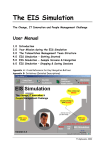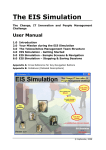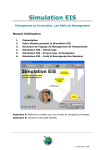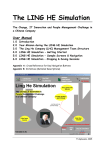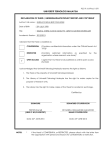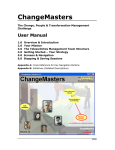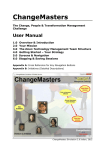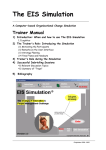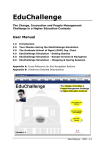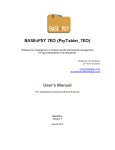Download User Manual
Transcript
The FAME Challenge
The Family Business Simulation
User Manual
1.0
2.0
3.0
4.0
5.0
6.0
Introduction
Your Mission during the FAME Challenge
The Peters Ltd. Management Team Structure
FAME Challenge - Getting Started
FAME Challenge - Sample Screens & Navigation
FAME Challenge – Stopping & Saving Sessions
Appendix A: Cross Reference for Key Navigation Buttons
Appendix B: Initiatives (Detailed Descriptions)
© AlphaLabs, 2004
The FAME Challenge
A multimedia organizational dynamics simulation on
managing change in family business contexts
1.0 Introduction
In the FAME Challenge, you will be challenged to introduce an innovation in a family business,
Peters Ltd.
Your mission, as formulated in more detail in the next section, is to spend the next 6 months
trying to convince the Peters Ltd. top management team (which includes a number of members
from the Peters family) to start engaging in management and ownership succession planning.
As displayed in the enclosed screens of the simulation, you will be able to choose among many
different initiatives to meet your goal. In some cases, you may gather information on the
managers (for example who drinks coffee with whom, etc.). In other cases, you may take direct
action to try to convince the managers and thus influence their willingness to adopt the proposed
innovation.
Each time you implement an initiative, you will receive feedback about the impact of your decision
immediately. The objective is to get as many adopters as possible in the shortest time.
The following screens illustrate in more detail the purpose and the main elements of the FAME
CHallenge, and explain the navigation of the screens, should you have any difficulty.
Page 2
© AlphaLabs, 2004
2.0 Your Mission during the FAME Challenge
First, review your mission by clicking on the ‘Mission’ button in the upper right oval box of the
screen. You will then access the ‘Mission’ screen which has 4 buttons called ‘The Context’, ‘The
Transformation’, ‘Your Challenge’ and ‘How to go about it’. The information you will access is
shown in the following four screens.
You are Alexandra Peters, a 41-year old cousin, who does not work in the family business. Your
father, Frank Peters, is the current CEO and owns 27% of the stock. He is 63 years old. Your
family has not developed plans for ownership transitions or the participation of the next
generation.
Your challenge is to persuade your family to begin the planning process involving the third
generation. For Peters Ltd. planning for the transition to the next generation is a significant step
with many emotional and business consequences. As you will experience - the process of changing
how people think, behave, and adopt innovations in organizations is never easy!
Persuading families to address critical issues related to management and ownership succession is
challenging and often requires a combination of different tactics to be used at the right time
with the right people. This simulation will make it possible for you to experiment with the
different actions and interventions designed to help your family decide it is time to develop
parallel plans for the business and family related to strategy, ownership, governance and
management.
Page 3
© AlphaLabs, 2004
As you might know, a family ownership continuity and business strategy plan provides everyone
with the processes they need to make timely and effective decisions. The planning process will
allow senior management to develop a strategy that is supported by the family ownership group.
Peters Ltd. based in London, is the largest manufacturer of plastic packaging materials for the
pharmaceutical industry in Great Britain. The company has designed all of its packaging equipment
and sells this equipment to non-competing manufacturers.
The stock is completely controlled by the Peters family with the three brothers Alfred
(Chairman of the Board), Frank (CEO and President) and Gene (COO and EVP) owning over 80%,
and the remaining shares in trusts for the third and fourth generations controlled by the board
of directors.
The senior generation has expressed a strong interest in remaining privately held despite a
worldwide consolidation of the packaging industry and interests from larger competitors in
buying the firm.
Page 4
© AlphaLabs, 2004
Remember! Your challenge is to persuade the senior management team, the board of directors,
and the family to begin a parallel planning process to address transferring ownership and
leadership to the next generation. Starting now, over the next 6 months, you will be able to:
==> Gather information,
==> Implement 'change tactics'/ initiatives,
==> Continuously monitor your progress in helping the 24 members of the family, board and
management team to move through the phases of AWARENESS and INTEREST building, then
TRYING and finally committing to (ADOPTING) the really significant - and potentially
controversial - innovation you are trying to introduce here.
In short, your personal objective is to get as many family and board members and both family and
non-family executives as possible to support the succession planning process! This is the standard
you have set for yourself to evaluate your change agents's team performance at the end of the 6
months.
Good luck!
Page 5
© AlphaLabs, 2004
First of all - before plunging into your first decision - we advise you to:
(1) Try to understand the context/scenario in which you are going to operate. You have never
worked in the family business. Actually you don't know the management and over a long time you
have not been close to your own or extended family! Following your mother's death two years ago
you have reconnected with your father and brother. Your extended family members (aunts,
uncles and cousins) respect your intellectual accomplishment but do not really know you.
(2) Review the different initiatives you will be able to launch to progressively impact and change
people behavior in order to shape positive attitudes toward the planning process!
(3) In case you haven't done it yet, allocate at least 15 minutes to develop or fine-tune a "general
strategy" which will guide you through the project ("top-down", "bottom-up", senior family
members, organizing the cousins, educating the entire family, working with the board etc.) and
write it down in the Strategy section.
To leave the ‘Mission’ screens, click on the ‘Back to the Action!’ button.
Page 6
© AlphaLabs, 2004
3.0 The Peters Ltd. Management Team Structure (OrgChart)
The above screen, ‘Org Chart’, shows what is displayed if you click on the ‘Org. Chart’ button at
any time during the simulation once you begin.
It is the organisational chart of the management team of Teleswitches Ltd in which you are
expected to introduce your innovation during the next 6 months.
The management team of the company consists of 22 managers, an External Financial Controller
and the Corporate Secretary. The picture of each person appears when you position the cursor on
the name. If you then click on the box, you will also get the profile of that person.
You can access this chart at any time during the simulation, and return to where you were in the
simulation by clicking the ‘Back to the Action’ button.
Page 7
© AlphaLabs, 2004
4.0 FAME Challenge – Getting Started
Your second action should be to click on the ‘Strategy’ button in the middle oval box of the
screen and summarize the strategy you are planning to adopt. Include any revision you may have
during the simulation, for instance, after having gathered more information on the organisation
and its managers. Click on ‘Back to the Action’ when completed.
To start the simulation, click on “Enter new session” (oval box on the bottom right of the screen).
A screen similar to the one below will appear. You have to enter your Personal Password to start
the simulation.
Page 8
© AlphaLabs, 2004
5.0 FAME Challenge – Sample Screens & Navigation
5.1 Control Panel
On the left hand side of the screen you will see displayed the list of the managers you are trying
to convince to adopt the transformation.
A variety of information about these managers can be accessed from this ‘Control Panel’ screen
(depending on the initiatives you take). A status on what you know about a person can be accessed
by placing the cursor over the bubble to the left of the person’s name. A personal profile can be
retrieved by clicking on the (i) bubble to the left of the person’s name.
The red bars displayed in the box to the right of the managers' names indicate how successful
you are being in changing the attitude of each manager in relation to adopting the transformation
during the simulation. This is dependent on the initiatives you decide to implement (you will be
able to see an overview of these initiatives on the right hand side of the screen).
You can see that the managers all go through a cycle of adoption, although at different paces,
and can be ‘not aware’, ‘aware’, ‘interested’, have acceted to seriously appraise and try out your
suggestions for new planning processes (‘trying’ phase) or have ‘adopted’ it.
You can access the ‘Control Panel’ anytime to monitor your progress on the top left hand side of
the screen.
Part of the scoring summary at the end of the simulation is a function of the red bars
representing the degree of positive attitude that you have achieved for each manager.
Page 9
© AlphaLabs, 2004
5.2 Personal Profile
The left hand side of the above screen shows an example of the personal profile, which can be
accessed by clicking on the (i) bubble to the left of the person’s name or clicking on their name
from the ‘Org Chart’ screen. You can also switch quickly between Personal Profiles by clicking on the
arrows on either side of the person’s image. Access to this information is dependent on the
initiatives you have taken.
Click the ‘Control Panel’ button on the top left of the screen to return to the list of all managers.
5.3 Status
The right hand side of the above screen shows a status on what you know about a person. This
can be accessed by placing the cursor on the left of the person’s name without clicking.
Page 10
© AlphaLabs, 2004
5.4 Initiatives
On the right hand side of the screen, if you click on the ‘Initiatives’ button you will see the above
screen, which lists the change management initiatives you may launch during the simulation.
A description of a particular initiative will be displayed below this list if you click on any title. You
may also click on ‘Detailed Descriptions’ (in the lower half of the right hand screen) and scroll
through the descriptions of all initiatives at once (see Appendix A).
You may also take a decision from the ‘Initiatives’ screen. To implement an initiative from this
screen, highlight the initiative and click on ‘Implement It’. This will bring the ‘Take Decision’
screen up (see 5.5) with the initiative already chosen, and a prompt for any other details you
need to provide (ie. the names of people involved).
Page 11
© AlphaLabs, 2004
5.5 Take Decision
On the right hand side of the screen, if you click on the ‘Take Decision’ button you will see the
above screen, which shows the number of the decision you are about to take.
To implement an initiative, click on the “Your initiative” box and select the initiative from the
drop down menu that appears. You will also be prompted for any other details you need to provide
(ie. Names of people involved). This can be chosen either by clicking on the name of the person on
the ‘Control Panel’ (left hand side of screen), or clicking on the box, and selecting the manager (s)
from the drop down menu of names. If you make a mistake in choosing the initiative or name, or
click on the box with the wrong details in it, select ‘Don’t Do It’ instead of “Implement the
Decision’ at the bottom of the screen.
For each decision, you should complete the ‘Your rationale for this decision’ box. Finally, click on
‘Implement the Decision’. You will receive immediate feedback on your chosen initiative. You will
receive a summary of the outcome, a positive or negative indication of any attitude changes of
the managers involved (and maybe not involved), and the clock will continue ticking off along the
bottom of the screen (against the 6 months) for the time taken to implement the initiative.
Page 12
© AlphaLabs, 2004
5.6 Org Networks button
Click on ‘Org Networks’ and you can access information regarding the managers - who has coffee
with whom – (‘Coffee’), who socialises with whom – (‘Social’) and who is on which task force with
whom – (‘Task Forces’). Access to this information is dependent on the various initiatives you have
implemented.
5.7 Insights & Issues
This version of the Simulation provides the possibility to take notes anytime during a session.
This Learning Notebook, accessible by selecting
in the upper right side of the
screen also provides a structured way to summarize key insights and issues after completing a
session.
You may fill in the Do’s column on the screen to share “Insights” of what you have learned from
the experience as well as Dont’s column for the “Issues” of Change Management you would like
to know more about. You are able to print it on paper or on a slide. The content of the Do &
Dont’s sheet is recorded in the Session Report.
Page 13
© AlphaLabs, 2004
5.8 Track Record
Click on ‘Track Record’ at any point during the simulation and you will see a summary of your
initiatives to date that you can scroll through. For a detailed history of your Initiatives: Decision
#, Initiative, Rationale, Outcome (ie. the immediate feedback), and No. of Adopters to date –
click on ‘History Details’ and scroll through your results.
Page 14
© AlphaLabs, 2004
5.9 Score
This shows the score sheet that is displayed if you click the "Score" button located on the
bottom middle of the screen.
You may click on this at any time to see how you are progressing, and you can return to the
simulation by clicking on the buttons at the top of the screen.
The thin blue line on the graph (the top one) indicates the cumulative ‘positive attitude’ (ie. the
red bars) you have succeeded in gathering. As you can see in the example in the screen above, the
cumulative positive attitude can decrease too during the project, depending on your initiatives
and other events that can happen during the 6 months implementation period!
The thick red line (the bottom line) indicates the cumulative number of managers you have
convinced to adopt. Once someone has adopted they cannot move back through the adoption
process.
The numeric scores, the number of ‘Days per Adopter’, Elapsed Time, ‘# of Adopters’, and ‘# of
Decisions’ ‘# of Attitude Points’ are on the top left of the screen.
Page 15
© AlphaLabs, 2004
5.10 FAME Challenge Save Session Report
You may save your session’s report at any time during the simulation by clicking on the “Save
Session Report” button on the right hand side of the “Score” screen. The report allows you to
get details about the session including: the date of running, number of adopters, number of
initiatives and the time spent to implement these initiatives and of course the key points of the
adopted strategy and also the content of do and dont’s learning points. Beside you will also get
all the information on the adoption stage of each person as well as the feedback for each
implemented initiative.
5.11 FAME Challenge Credits Screen
This screen provides information about the simulation and those who have contributed to its
design, development and continuous updating. It is displayed if you click on the ‘FAME Challenge’
button located on the bottom left hand corner of every screen.
Page 16
© AlphaLabs, 2004
5.12 FAME Challenge Print
The ‘PRINT’ button allows the printing of any page in the Simulation (e.g the SCORE page). In
case you print directly on a transparency, you will have to insert the transparency in the printer
and choose the appropriate printing options.
6.0 FAME Challenge – Stopping & Saving Sessions
6.1 Stopping & Restarting
This version of the Simulation allows you to “stop” a session anytime you want and “resume” it at
a later stage. To “stop” the session, just quit the simulation software by selecting
. The
current session will be automatically saved in the file “EISMission.eis”. To “restart” a session
just select
which will appear automatically on the Main
Screen the next time you will enter the simulation software.
6.2
Automatic Saving before Quitting a Session
This version of the Simulation automatically saves a copy of the session every time you quit the
simulation software (in addition to producing the Report in editable form). Hence the latest
state of the session is always stored in the file “EISMission.eis” and can be reloaded. You can
always
restart
your
session
from
the
point
you
left
it
by
selecting
after restarting.
Page 17
© AlphaLabs, 2004
APPENDIX A
Cross Reference for Key Navigation Buttons (at Top of Screen)
Control Panel (People & Progress)
Org. Chart
Org. Networks
Initiatives
Track Record
Insights & Issues
Take Decision
Our Strategy
Refer 5.1
Refer 3
Refer 5.6
Refer 5.4
Refer 5.8
Refer 5.7
Refer 5.5
Refer 4.0
Cross Reference for Key Navigation Buttons (at Bottom of Screen)
Mission
Score
Print
Quit
FAME Challenge (Credits)
Page 18
Refer 2.0
Refer 5.9
Refer 5.12
Quit
Refer 5.11
© AlphaLabs, 2004
INITIATIVES
SEEK ADVICE: Organize a meeting with any one member
of the top management team or with any of the family
members in order to get some advice on how to approach
the transition planning project in the most effective
manner. (2 days) NOTE - You will not actually receive
advice in the feedback; the aim is to influence the person
you visit through a ‘humble’ approach
GET PROFILES: Build a personal profile on any five
members of the top management team or of the Peters
family by talking informally with some junior managers. (2
days) NOTE - Each person's profile includes a qualitative
description of the individual and a quantitative indication
of how many 'attitude points' will be needed to move that
individual through the four change phases.
TASK FORCES: Discover which top managers are on the
company's three main task forces. (1 day) NOTE - These
membership lists will not change, and will remain available
throughout the simulation.
INTERNAL MAGAZINE: Ask the editor of the internal
magazine to include a short article you write on the
advantages that Transition Planning Processes can bring to
family businesses. (3 days) NOTE - This magazine is
distributed to everybody. The article is about the generic
advantages of introducing Transition Planning Processes in
family firms, and does not include any company specific
information.
CHAIRMAN DIRECTIVE: Try to convince the Chaiman to
send out a directive to everyone on the board and in the
family insisting that they start the transition process
asap. (7 days) NOTE - You spend several days writing a
draft of this directive to give to the Chairman.
COVERT LOBBYING: Without sharing your plans, suggest
to the Chairman and to some other family members that
they work with you behind the scenes to persuade the
Board members (and particularly the outside ones) to
accelerate the implementation of the transition planning
project. (8 days) NOTE - This tactic assumes that you
have identified the appropriate key individuals to
approach, and does not require you to specify them.
ELECTRONIC MAIL: Send a brief electronic mail to
everyone on the top management team explaining your
ideas on why a transition planning project makes sense
for them. (1 day) NOTE - All of the top managers have
an individual E-mail account.
EXECUTIVE EDUCATION: For five family members from
the management team, organize a weeklong training
program at a business school on the potential benefits of
family transitions and how to plan them. (5 days) NOTE
- You do not attend the program, but it takes a
considerable amount of your time to plan it. In addition,
managers can only attend such programs once a year.
DIRECTORS MEETING: Organize a special board of
directors meeting in the main conference room with all
the seven directors to share and discuss thoughts and
plans for the transition project. (3 days) NOTE Directors are informed that they can also bring along
managers from their group.
Page 19
APPENDIX B
FAMILY WORKSHOP: Help the Training Manager organize
and lead a discussion session on Fair Process for all
interested family members. Specific issue addressed
include: communication, consistency, clarity, changeability
and commitment to fairness.(5 days) NOTE - This will
provide the opportunity for the workshop leader to share
and gather views and experiences on how to best manage
the transition process.
FACE-TO-FACE MEETING: Fix a meeting with one of the
top managers or family members in order to persuade
him/her that the transition project has great advantages
and that it would make sense for him/her to support and
actively participate in the Transition Planning Process. (1
day) NOTE - The meeting will take place in the
manager's office.
SOCIAL NETWORKS: Spend some time at the company
bar in order to see which groups of top managers or
family members meet regularly for a coffee, lunch or
other opportunities for social gatherings. (3 days)
NOTE - These groups will not change, and the list will
remain available throughout the simulation.
FAMILY MEETING: Fix a meeting with up to 5 family
members (parents/children/cousins) to discuss ownership
expectations. (1 day) NOTE - Your invitation is
distributed in the company internal mail system.
PILOT MEETINGS: Try to get commitment from one of
the top managers by asking him/her to organize a series
of structured meetings in which participants will be able
to start realizing the concrete implications of fully
engaging into a Transition Planning Process. (4 days)
NOTE - This will involve preparing brief overview material
focusing on Transition Planning Processes to be sent in
advance.
FAMILY RETREAT: Develop a family retreat to explore
the family’s future plans and vision. (5 days) NOTE - All
the members of the family are in principle expected to
attend such retreats.
QUESTIONNAIRE: Write and distribute a questionnaire
aimed at assessing the firm’s strategic potential and the
current level of interest in engaging into a Transition
Planning Process. (2 days) NOTE - The main objective of
using this tactic is to demonstrate your approach to the
project rather than gathering additional information.
EXTERNAL SPEAKER: Organise a speaker event in which
Professor Tom Anderssen, an expert on family
businesses, will deliver an address entitled: “Managing
Transitions: Liberating Competencies and Synergies in
Family Businesses”. (5 days) NOTE - Everyone in the
company is invited by memo to this event, but attendance
is optional.
FAMILY NETWORKS: Spend some time observing or
finding out more about the family and its Genogram. (5
days) NOTE - These groups will not change, and the
genogram will remain available throughout the simulation.
© AlphaLabs, 2004
© AlphaLabs, 2004




















